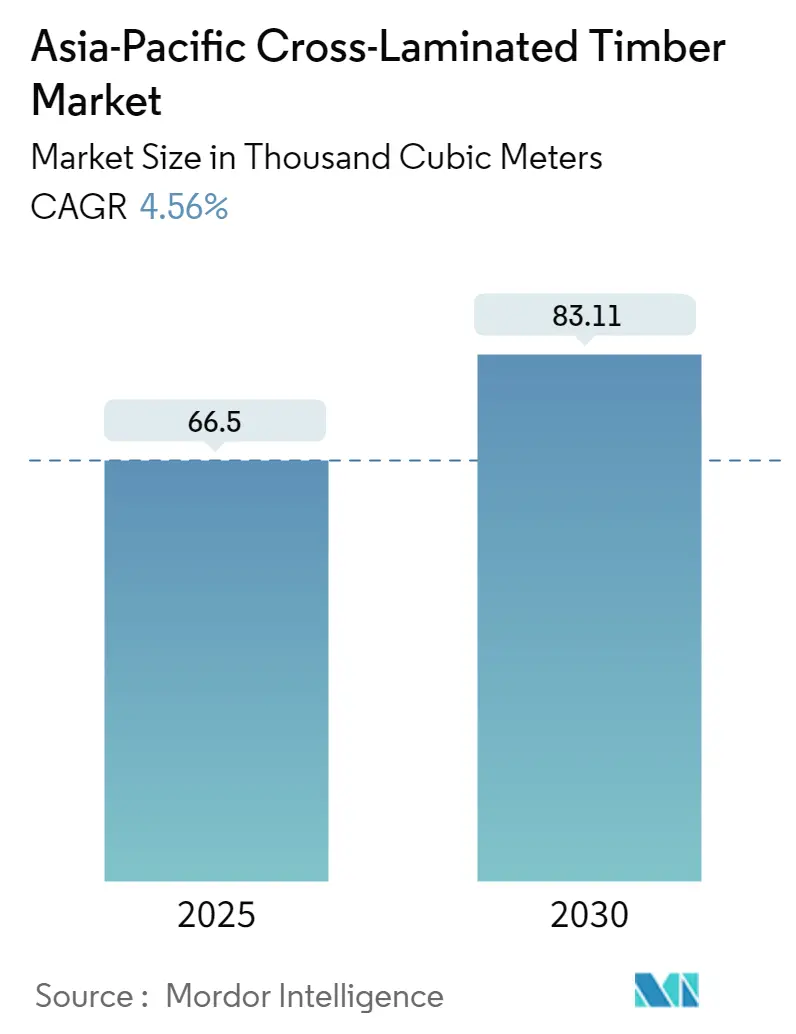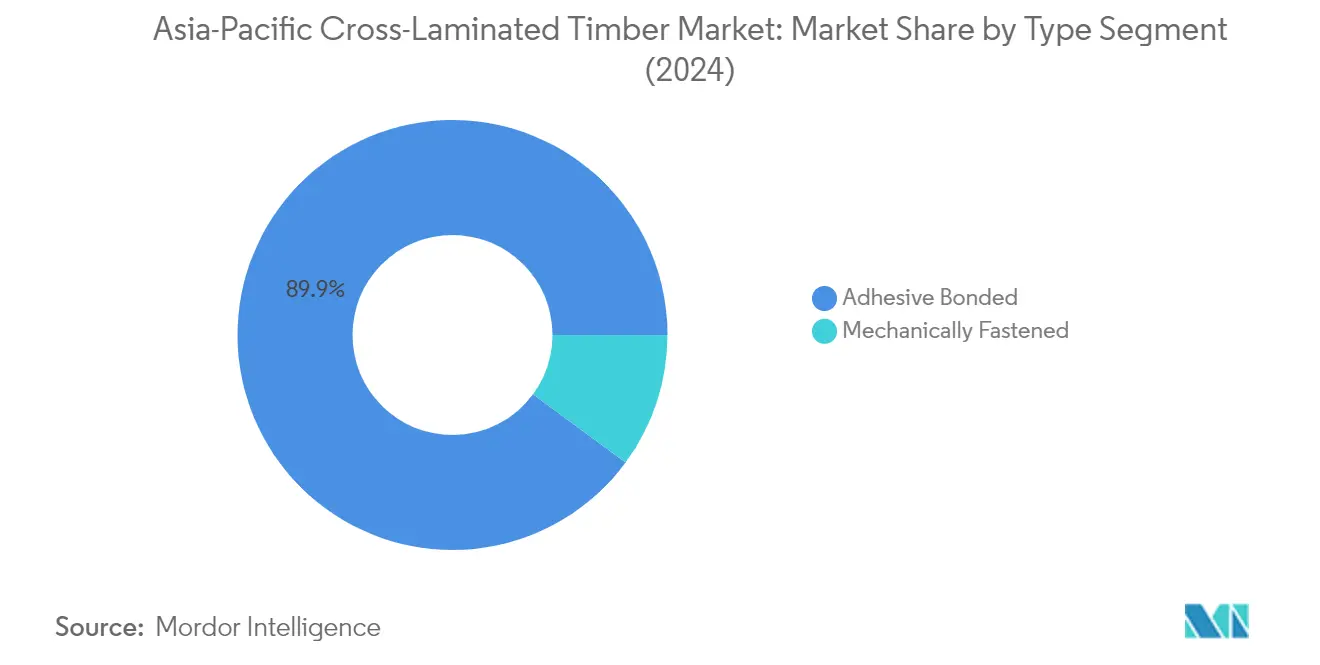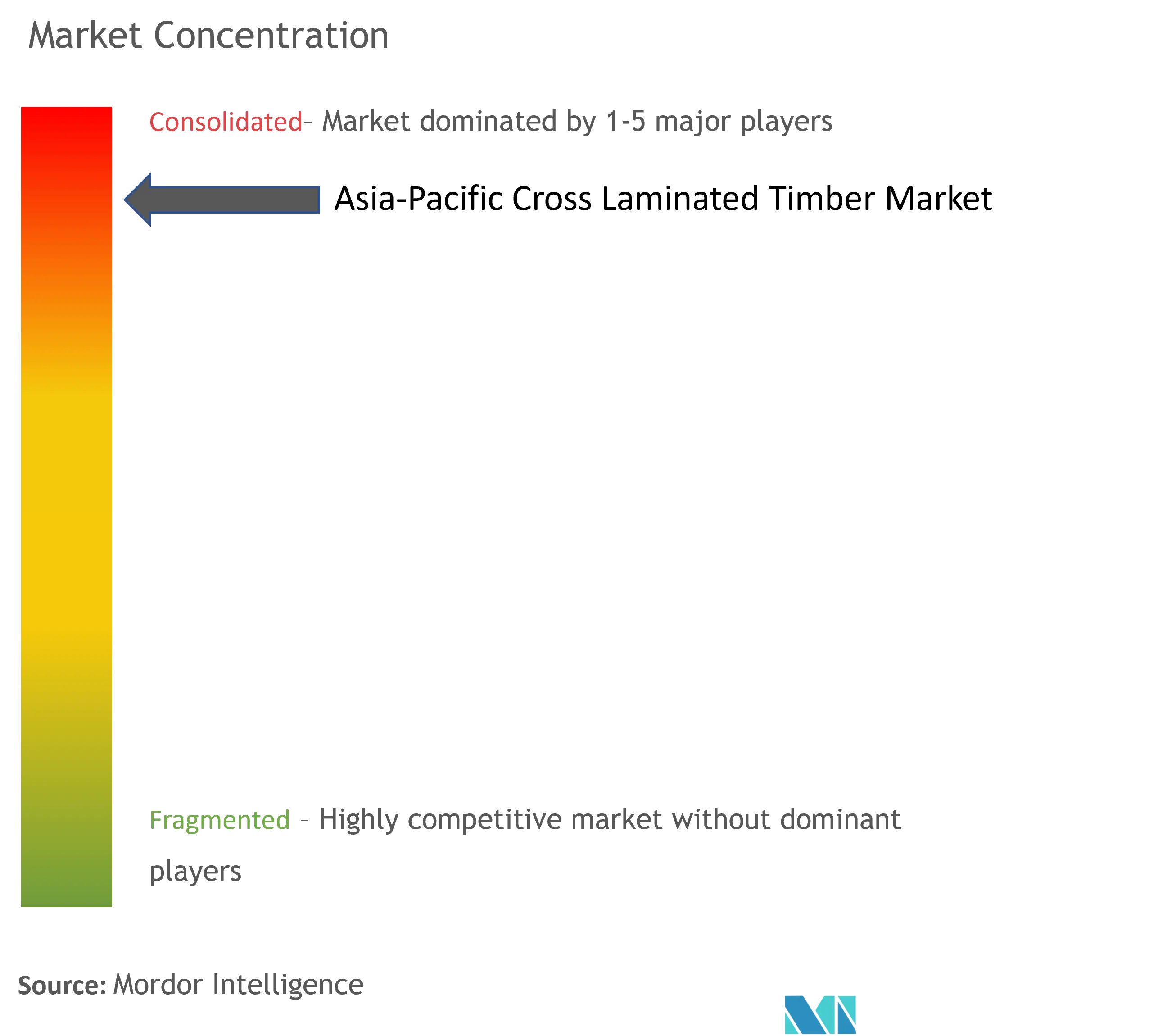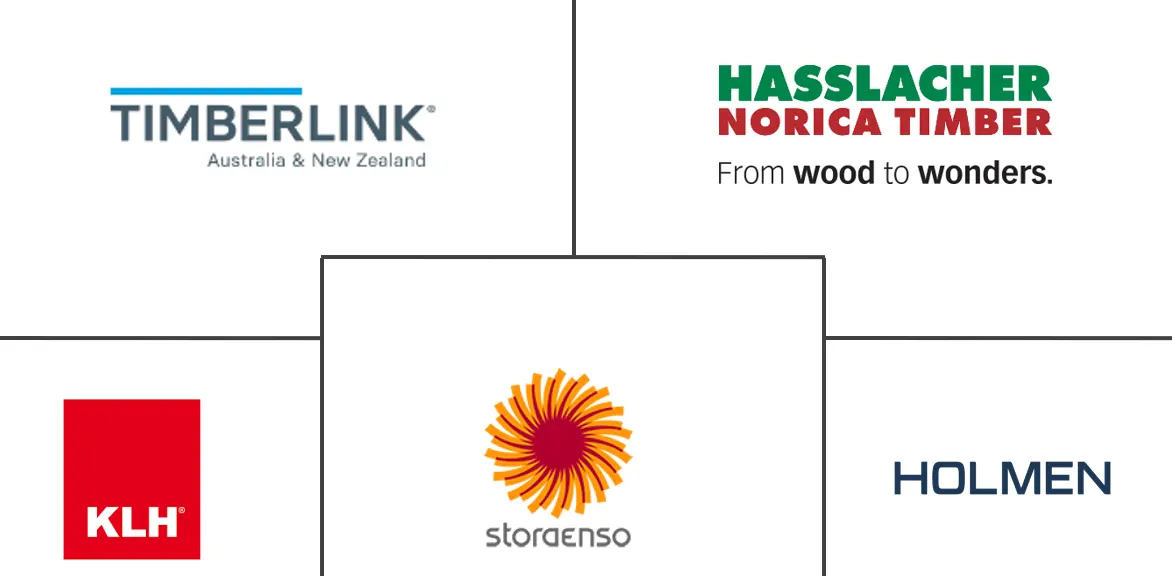Asia-Pacific Cross-Laminated Timber Market Size and Share

Asia-Pacific Cross-Laminated Timber Market Analysis by Mordor Intelligence
The Asia-Pacific Cross-Laminated Timber Market size is estimated at 66.50 thousand cubic meters in 2025, and is expected to reach 83.11 thousand cubic meters by 2030, at a CAGR of 4.56% during the forecast period (2025-2030).
The Asia-Pacific construction industry is experiencing significant transformation with the adoption of sustainable building materials and technologies. In China, the construction sector remains a key economic contributor, with construction output reaching CNY 31.2 trillion (USD 4.5 trillion) in 2022, demonstrating the robust foundation for cross-laminated timber adoption. The region's commitment to sustainable construction materials practices has led to the development of innovative building solutions, particularly in high-density urban areas where the demand for efficient and environmentally conscious construction methods continues to grow. The integration of mass timber construction techniques has gained prominence across major metropolitan areas, reflecting a broader shift towards green construction materials practices.
The commercial real estate sector has emerged as a significant driver for sustainable construction materials. In India, office space occupancy across six major cities reached 54.8 million square feet in 2022, registering substantial growth and creating opportunities for cross-laminated timber applications. The trend towards sustainable office spaces has been particularly evident in premium developments, where developers are increasingly incorporating mass timber elements to meet both environmental and aesthetic requirements. This shift is further supported by government initiatives and corporate sustainability goals, leading to increased adoption of wooden construction materials in commercial projects.
The residential construction sector is witnessing a remarkable transformation with the integration of mass timber technologies. Housing projects in India's top 7 cities are expected to reach 5.6 lakh homes in 2023, presenting significant opportunities for cross-laminated timber applications. The Building and Construction Authority in Singapore has projected construction contracts worth SGD 27-32 billion in 2023, with public sector developments accounting for approximately 60% of the total construction demand. This substantial pipeline of projects, particularly in public housing and educational facilities, demonstrates the growing acceptance of innovative construction materials.
Recent developments in institutional construction showcase the increasing adoption of cross-laminated timber across the region. In May 2023, Singapore unveiled Asia's largest mass timber building, the Gaia building at Nanyang Technological University, demonstrating the material's potential in large-scale institutional projects. The University of Newcastle announced the construction of its new cross-laminated timber building in September 2023, while Melbourne's T3 mass timber office project, announced in May 2023, aims to reduce carbon emissions by 34% compared to traditional construction methods. These developments are complemented by initiatives such as the Confederation of Real Estate Developers Association of India's April 2023 partnership with the Indian Green Building Council, pledging to certify 1,000 projects as green buildings over two years.
Asia-Pacific Cross-Laminated Timber Market Trends and Insights
Growing Commercial Sector in the Region
The commercial construction sector across Asia-Pacific has witnessed substantial growth, driving the demand for innovative and sustainable building materials like cross-laminated timber (CLT). This growth is evidenced by numerous landmark projects in 2023, including Singapore's Gaia building at Nanyang Technological University, which stands as Asia's largest mass timber building. The project, led by Toyo Ito & Associates, demonstrates the increasing adoption of cross-laminated timber in institutional construction, marking the second mass timber building on the NTU campus. Similarly, the University of Newcastle in Australia initiated the construction of a new CLT building valued at AUD 58 million, representing the first mass timber building on the NSW Central Coast.
The aviation sector has also embraced CLT and related engineered wood products, as demonstrated by the Mactan International Airport in the Philippines, which became Asia's first airport featuring a roof structure composed entirely of glulam. This structural material, produced from individual wood segments, offers exceptional durability and humidity resistance, making it ideal for large-scale commercial applications. The versatility of cross-laminated timber in commercial construction extends to various applications, including beams, support structures, furniture, floors, walls, and ceilings, providing both structural integrity and aesthetic appeal to hotels, offices, and restaurants across the region.
Increasing Popularity of Cross-Laminated Timber Over Other Traditional Wood Materials
Cross-laminated timber has emerged as a preferred alternative to traditional construction materials, particularly steel and concrete, due to its impressive combination of environmental and structural benefits. The material's rising popularity is attributed to its relatively low carbon footprint, superior strength-to-weight ratio, and simplified installation process, making it an attractive option for sustainable construction projects. Additionally, CLT demonstrates exceptional technical properties, including high heat insulation, sound insulation, and fire resistance, while maintaining dimensional stability that surpasses traditional wood materials.
The material's growing acceptance is further supported by its versatility in prefabricated wood construction and compatibility with simple connectors, which significantly reduces construction time compared to traditional methods. The lightweight nature of CLT compared to reinforced concrete construction provides additional advantages in terms of transportation and foundation requirements. This shift towards CLT is particularly evident in China, the world's largest timber consumer, where the annual consumption reaches 570 million cubic meters, including 310 million cubic meters of imported timber. This substantial demand reflects the increasing recognition of CLT's advantages over traditional wood materials, particularly in the context of sustainable construction practices and environmental considerations.
Segment Analysis: Type
Adhesive-Bonded Segment in Asia-Pacific Cross-Laminated Timber Market
The adhesive-bonded segment continues to dominate the Asia-Pacific cross-laminated timber market, commanding approximately 90% of the total market share in 2024. This overwhelming market leadership is primarily attributed to the segment's superior bonding properties and widespread adoption in residential and non-residential construction sectors. Adhesive bonding has played a vital role in the growth and development of forest products and has been a major contributor to the efficient use of timber resources. The largest application can be found in producing building materials, namely plywood, structural flakeboards, particleboards, fiberboards, structural framing, timbers, architectural doors, windows, frames, factory-laminated wood products, and glass fiber insulation. The segment's growth is further driven by the fact that adhesive-bonded CLT aids in preserving wood and can create lightweight but robust structures while reducing the expansion and contraction of wood due to moisture retention. Additionally, the segment is experiencing the highest growth rate with a projected CAGR of around 5% through 2029, supported by increasing investments in sustainable construction and growing awareness about environmental benefits.

Mechanically Fastened Segment in Asia-Pacific Cross-Laminated Timber Market
The mechanically fastened segment represents a smaller but significant portion of the Asia-Pacific cross-laminated timber market. This segment offers unique advantages such as cost-effectiveness and successful construction of high-quality buildings, particularly supporting small CLT manufacturing operations in rural regions. The segment has gained traction due to its ability to support regions where pine beetle damage has affected wood that may not be suitable for dimensional timber but can be effectively used in laminated timber systems. Mechanically fastened CLTs are predominantly used in walls, ceilings, roof structures, and beams, offering flexibility in replacement and maintenance. The segment's growth is also driven by environmental concerns related to petrochemical-based adhesives and other hazardous materials, opening up new opportunities for market expansion in the region.
Segment Analysis: By Application
Non-Residential Segment in Asia-Pacific Cross-Laminated Timber Market
The non-residential segment dominates the Asia-Pacific cross-laminated timber market, commanding approximately 63% of the market share in 2024. This significant market presence is primarily driven by the extensive adoption of engineered lumber in commercial construction projects, particularly in countries like Japan, China, and Australia. The segment's dominance is further reinforced by the increasing focus on sustainable building materials in commercial spaces, with cross-laminated timber being recognized for its superior structural properties and environmental benefits. The commercial sector, in particular, has shown strong adoption rates, especially in office buildings, retail spaces, and educational institutions. The growing emphasis on green building certifications and carbon-neutral construction practices across the Asia-Pacific region has particularly benefited this segment, with many commercial projects specifically choosing cross-laminated timber for its sustainability credentials and aesthetic appeal.
Residential Segment in Asia-Pacific Cross-Laminated Timber Market
The residential segment in the Asia-Pacific cross-laminated timber market demonstrates robust growth potential, supported by increasing awareness of sustainable construction materials and growing demand for energy-efficient housing solutions. The segment's growth is particularly notable in Japan and Australia, where there is a strong push for environmentally conscious residential construction. The adoption of cross-laminated timber in residential projects is being driven by its superior thermal insulation properties, faster construction times, and reduced carbon footprint compared to traditional building materials. Additionally, the material's aesthetic appeal and ability to create comfortable living spaces has made it increasingly popular among homeowners and developers. The segment is also benefiting from supportive government policies promoting wooden construction and sustainable building practices across various Asia-Pacific countries.
Asia-Pacific Cross-Laminated Timber Market Geography Segment Analysis
Asia-Pacific Cross-Laminated Timber Market in Japan
Japan continues to dominate the Asia-Pacific cross-laminated timber market, commanding approximately 69% of the total market volume. The country's leadership in timber construction is driven by its strong commitment to sustainable construction practices and government initiatives promoting wooden buildings. The Mitsubishi Estate Group has been at the forefront of promoting Japanese-grown timber in construction projects, particularly focusing on expanding the use of cross-laminated timber. The country's forests, which make up about two-thirds of its land mass, provide a sustainable source for CLT production, with 40% being planted forests. Japan's construction sector maintains a positive outlook, supported by increasing investments in public infrastructure, renewable energy, and commercial projects. The country's emphasis on sustainable building practices and the growing acceptance of CLT in both residential and commercial construction sectors has created a robust market environment. The development of innovative projects like the Mitsubishi Estate's luxury apartments and various redevelopment initiatives continues to drive demand for cross-laminated timber in the country.
Asia-Pacific Cross-Laminated Timber Market in India
India represents one of the most dynamic markets for cross-laminated timber in the Asia-Pacific region, with a projected growth rate of approximately 5% from 2024 to 2029. The country's construction sector is undergoing a significant transformation with an increasing focus on sustainable building practices. The implementation of various government policies, such as the Smart Cities project and Housing for All, has brought significant impetus to the Indian construction industry. The country's commitment to green building initiatives is evident through partnerships between organizations like CREDAI and the Indian Green Building Council. The real estate sector's potential contribution to GDP could reach up to 30% due to its multiplier effect across 252 allied industries. The growing emphasis on sustainable construction technologies, coupled with the urgent need to address pollution concerns, has positioned cross-laminated timber as a preferred material for future construction projects. The development of ultra-modern hospitals, shopping malls, offices, and factories has created substantial opportunities for CLT applications, particularly in commercial buildings where demand for well-managed properties with exceptional infrastructure continues to rise.
Asia-Pacific Cross-Laminated Timber Market in China
China's cross-laminated timber market continues to evolve, driven by the country's massive construction sector and increasing focus on sustainable building practices. The construction industry remains highly active, with infrastructure construction being a major growth driver. The Chinese government's emphasis on boosting investments across the construction sector aims to stimulate overall economic growth, with particular attention to infrastructure projects. The country's commitment to green building practices is evident through new regulations requiring 70% of new urban buildings to be certified as green buildings, with major municipalities like Shanghai, Beijing, and Shenzhen planning to exceed these goals. The value-added of the construction industry is showing strong growth potential, particularly in commercial property construction and infrastructure projects. The government's continued support through various initiatives and policies has created a favorable environment for the adoption of cross-laminated timber in construction projects, particularly in regions focusing on sustainable development and environmental protection.
Asia-Pacific Cross-Laminated Timber Market in South Korea
South Korea's cross-laminated timber market is experiencing significant growth, driven by the increasing popularity of wood-framed buildings and new policies promoting urban decentralization. The country's construction-related industry, encompassing public and private infrastructure and civil engineering services, has shown remarkable development. The government's plan to promote passive and zero-energy buildings by 2025 has created new opportunities for cross-laminated timber applications. The mass timber industry in South Korea, though still in its early stages, is gaining momentum due to increasing demand for low-carbon construction and new building codes for large mass timber buildings. The size of South Korea's local construction market is expanding, primarily due to strong growth in private residential construction. The country's emphasis on sustainable building practices and the introduction of incentives to promote domestic wood use in construction have created a favorable environment for the growth of the cross-laminated timber market.
Asia-Pacific Cross-Laminated Timber Market in Other Countries
The rest of the Asia-Pacific region, including countries like Thailand, Malaysia, Bangladesh, the Philippines, Singapore, Australia, and New Zealand, demonstrates varying levels of adoption and growth in the cross-laminated timber market. These countries are experiencing different stages of market development, influenced by their respective construction sectors and sustainability initiatives. The construction industry in these regions is projected to show strong growth over the next fifteen years, particularly in countries like the Philippines, Vietnam, Indonesia, and Malaysia. These markets are characterized by robust population growth, rapid urbanization, and strong private-sector support. The increasing focus on sustainable construction practices and the growing awareness of environmental benefits associated with cross-laminated timber usage are driving market development. Government initiatives promoting green building practices and sustainable urban development continue to create opportunities for market expansion across these countries.
Competitive Landscape
Top Companies in Asia-Pacific Cross-Laminated Timber Market
The leading companies in the market are focusing on expanding their production capabilities and geographic presence through strategic acquisitions and partnerships. Companies are investing heavily in research and development to improve product performance and sustainability credentials, while also developing innovative applications for cross-laminated timber in construction. Operational excellence is being prioritized through digitalization initiatives, with companies implementing advanced manufacturing technologies and IoT solutions to optimize production processes. Market leaders are strengthening their vertical integration, particularly in securing sustainable timber sources and establishing efficient supply chains. Additionally, companies are expanding their service offerings to include technical support, design consultation, and customized solutions to better serve the growing construction sector demands.
Consolidated Market with Strong Global Players
The Asia-Pacific cross-laminated timber market exhibits a consolidated structure dominated by established global players with significant manufacturing capabilities and extensive distribution networks. These major players, primarily headquartered in Europe and North America, have established strong footholds in the region through strategic partnerships and local manufacturing facilities. The market is characterized by the presence of both diversified conglomerates that offer a wide range of wood products and specialists focused exclusively on engineered timber solutions. Recent years have witnessed increased merger and acquisition activities, particularly as companies seek to expand their production capacity and strengthen their market position in emerging economies.
The competitive landscape is evolving with the entry of regional players, particularly from Australia and Japan, who are leveraging their local market knowledge and established relationships in the construction industry. Market consolidation is primarily driven by the need for economies of scale in production and the high capital requirements for establishing manufacturing facilities. Companies are increasingly focusing on vertical integration strategies, from forest management to end-product distribution, to ensure supply chain stability and maintain quality control throughout the production process.
Innovation and Sustainability Drive Future Success
Success in the market increasingly depends on companies' ability to demonstrate environmental credentials and invest in sustainable practices throughout their operations. Market incumbents are strengthening their position by expanding their product portfolios with eco-friendly solutions and establishing strong relationships with key stakeholders in the construction industry. Companies are also focusing on developing proprietary technologies and obtaining certifications to differentiate their offerings in the market. The ability to provide comprehensive solutions, including design support and technical expertise, is becoming crucial for maintaining market share.
For new entrants and smaller players, success lies in identifying and serving niche market segments while building strong local partnerships. Companies need to focus on developing innovative applications for engineered wood and establishing efficient distribution networks to compete effectively. The regulatory environment, particularly regarding building codes and environmental standards, continues to shape market dynamics and create opportunities for companies that can adapt quickly. End-user education and awareness building remain critical factors for market expansion, with companies investing in demonstration projects and knowledge-sharing initiatives to promote the benefits of cross-laminated timber construction.
Asia-Pacific Cross-Laminated Timber Industry Leaders
-
Stora Enso
-
Timberlink Australia & New Zealand
-
KLH Massivholz GmbH
-
HASSLACHER Holding GmbH
-
Holmen
- *Disclaimer: Major Players sorted in no particular order

Recent Industry Developments
- February 2023: HasslacherHolding GmbH acquired a 40% stake in Egoin Wood Group. With production sites in Ea (Biscay) and Legutio (Araba), this globally engaged company has more than 30 years of experience in the creation of construction timber solutions. The overall production capacity for engineered wood products at Egoin Wood Group was 22,000 m3 (14,000 m3 cross-laminated timber and 8,000 m3 glulam), but that capacity was anticipated to increase to up to 52,000 m3 when the third cross-laminated timber plant in Legutio opened in mid-2023.
- October 2022: Stora Enso announced its product, Sylva. It is a massive wood building kit comprising pre-manufactured, custom-made applications delivered in time to the building site. Stora launched this product to meet the demand for sustainable and innovative construction solutions and strengthen its business in the sustainable wood structure market for low-carbon buildings.
Asia-Pacific Cross-Laminated Timber Market Report Scope
Cross Laminated Timber (CLT) is an engineered wood product, consisting of planks of sawn, glued, and layered wood, where each layer is oriented at right angles to one another and then glued to form structural panels. By joining layers of wood at perpendicular angles, structural rigidity for the panel is obtained in both directions, similar to plywood but with thicker components.
The Asia-Pacific cross-laminated timber market is segmented by type, application, and geography. By type, the market is segmented into adhesive bonded and mechanically fastened. By application, the market is segmented into residential and non-residential (commercial, industrial/institutional, and other applications). The report also covers the size and forecasts for the cross-laminated market in four countries across the Asia-Pacific. For each segment, the market sizing and forecasts have been done based on volume (thousand cubic meters).
| Adhesive Bonded |
| Mechanically Fastened |
| Residential | |
| Non-Residential | Commercial |
| Industrial/Institutional | |
| Other Applications |
| China |
| India |
| Japan |
| South Korea |
| Rest of Asia-Pacific |
| Type | Adhesive Bonded | |
| Mechanically Fastened | ||
| Application | Residential | |
| Non-Residential | Commercial | |
| Industrial/Institutional | ||
| Other Applications | ||
| Geography | China | |
| India | ||
| Japan | ||
| South Korea | ||
| Rest of Asia-Pacific | ||
Key Questions Answered in the Report
How big is the Asia-Pacific Cross-Laminated Timber Market?
The Asia-Pacific Cross-Laminated Timber Market size is expected to reach 66.50 thousand cubic meters in 2025 and grow at a CAGR of 4.56% to reach 83.11 thousand cubic meters by 2030.
What is the current Asia-Pacific Cross-Laminated Timber Market size?
In 2025, the Asia-Pacific Cross-Laminated Timber Market size is expected to reach 66.50 thousand cubic meters.
Who are the key players in Asia-Pacific Cross-Laminated Timber Market?
Stora Enso, Timberlink Australia & New Zealand, KLH Massivholz GmbH, HASSLACHER Holding GmbH and Holmen are the major companies operating in the Asia-Pacific Cross-Laminated Timber Market.
What years does this Asia-Pacific Cross-Laminated Timber Market cover, and what was the market size in 2024?
In 2024, the Asia-Pacific Cross-Laminated Timber Market size was estimated at 63.47 thousand cubic meters. The report covers the Asia-Pacific Cross-Laminated Timber Market historical market size for years: 2019, 2020, 2021, 2022, 2023 and 2024. The report also forecasts the Asia-Pacific Cross-Laminated Timber Market size for years: 2025, 2026, 2027, 2028, 2029 and 2030.
Page last updated on:



